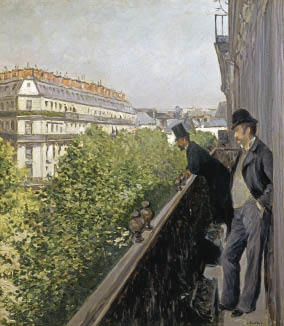In 1879, two young brothers moved into a new fifth-floor apartment at no. 31 Boulevard Haussmann, overlooking the Opéra. Flush with inheritances from their father’s army bunk business, Gustave Caillebotte, 31, and his brother Martial, 26, were exactly the sort of children of the Second Empire for whom these new Parisian mansion blocks had been built.
In 1879, two young brothers moved into a new fifth-floor apartment at no. 31 Boulevard Haussmann, overlooking the Opéra. Flush with inheritances from their father’s army bunk business, Gustave Caillebotte, 31, and his brother Martial, 26, were exactly the sort of children of the Second Empire for whom these new Parisian mansion blocks had been built.
In some ways, though, the brothers were atypical of their leisured class, for they were both exceptionally — in Gustave’s case furiously — industrious. Alongside shared passions for stamp collecting and yachting, Martial studied at the Conservatoire and became a composer, while Gustave, after attending the Ecole des Beaux-Arts, threw in his lot with the Impressionists. He bought their paintings, subsidised their exhibitions and mended fences between artistic factions. The critic Duranty went so far as to say that without him Impressionism wouldn’t have happened, and it’s certainly true that the Caillebotte Bequest, forced on a reluctant French State by his executor Renoir, forms the core of the Musée d’Orsay’s Impressionist collection. One of its highlights, Renoir’s ‘Bal du Moulin de la Galette’, appears in the ‘Self-portrait with an Easel’ Caillebotte painted just after his move to the Boulevard Haussmann.
For nearly a century, this was the legacy he was remembered for. Of the 500-odd paintings he produced before his death aged 45 from pulmonary congestion, most remained in his family. Unlike his fellow Impressionists he had no need to sell work, and this freedom could explain the sense of detachment that strikes us today as startlingly modern. Among his peers, Caillebotte had a unique perspective on Paris. In contrast to the cheerful bustle of Monet’s ‘Boulevard des Capucines’ or Pissarro’s ‘Boulevard Monmartre’, Caillebotte’s views of the Boulevard Haussmann from the balcony of his flat are almost achingly empty. The little black figures promenading below are alone with their shadows, and even the two men on the ‘Balcony, Boulevard Haussmann’ have nothing to say to each other, standing feet apart surveying a street they can’t actually see, since it is hidden behind a screen of trees.
This picture, painted in 1880, is now back on the Boulevard Haussmann in the Jacquemart-André Museum’s exhibition Dans L’Intimité des frères Caillebotte, Peintre et Photographe, which sets Gustave’s paintings alongside Martial’s amateur photographs. The intimacy is all on Martial’s side. Images of the Caillebotte children licking pudding spoons, of Martial grooming his beard at the bathroom window and even of Mme Martial in the tub — with the water modestly up to her chin — admit us to the privacy of the family album. Gustave’s portraits, on the other hand, give nothing away. Martial’s photographs of Paris serve to underline further the strangeness of his brother’s vision, with its curious perspectives, sharp diagonals, multiple vanishing points and grilles and trellises barring the view.
It’s Gustave who has the photographer’s eye. His close-up of the iron trellis of the Pont de L’Europe or his bird’s-eye view of the pavement below his balcony with figures walking towards us out of the frame could be opening shots in a film cut short at the credits. His interiors, too, have a filmic quality. The wide-angle half-lit view of ‘Luncheon’ in the family dining-room, with the glassware performing a spectral square dance on the massive table while mother and son attend to their plates in silence, is a Bergmanesque study in bourgeois alienation. ‘Woman Reading’ and ‘Woman at a Window’ also communicate ennui through an airless quality of light: for Huysmans, these two interiors epitomised the light of modern Paris, ‘deadened by window hangings, filtered by the muslin of inner curtains’. But Caillebotte can even pull the same trick outdoors. In ‘Portraits in the Country’ he pictures four female relatives dutifully sewing in the shade of the house while behind them the red-hot blaze of geraniums seems to challenge them to loosen their stays.
Caillebotte was not a great painter in the narrow meaning of the word. There’s no poetry in his brushwork or his colouration, which has a northern tendency to cling for safety to greys and neutrals — contemporary critics diagnosed ‘indigomania’. His touch seems almost deliberately anti-sensual; unlike his friend and executor Renoir, he didn’t ‘paint with his prick’. But although the ‘tenacious masonry’ Duranty admired in his painting doesn’t suit his later subjects of flowers and water, it does the business when applied to masonry or ironwork. It hardly matters that he handles the Pont de l’Europe like a workman painting the Forth Bridge.
Like his urban ‘Oarsman in a Top Hat’ rowing on the Seine, Caillebotte was a cultural fish out of water. He didn’t buy into the Impressionist vision of modern Paris as a colourful and carefree social mix. In his pictures the working classes aren’t out enjoying themselves — they’re either working or back home in the banlieues, leaving the boulevards to the men in top hats. We don’t know how he felt about this remodelled city whose new balconies and bridges he recorded. While some bemoaned the tyranny of the Haussmann straight line, Caillebotte’s compositions appear to embrace it. But his Paris streets never meet in comfortable vanishing points, and his Parisians lead parallel lives.






Comments